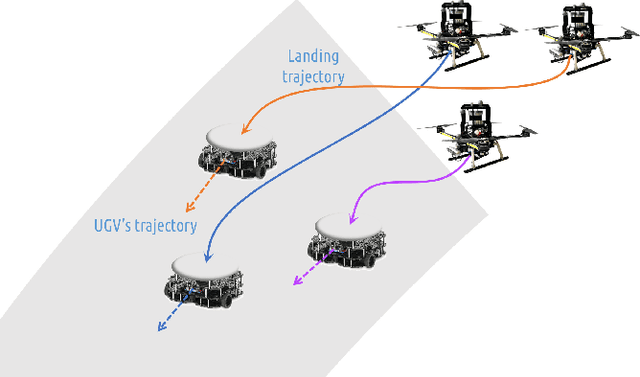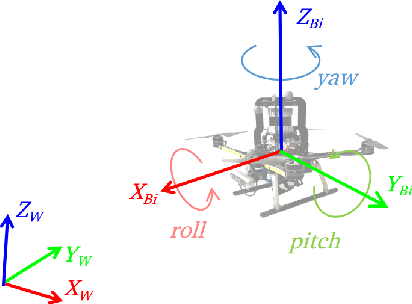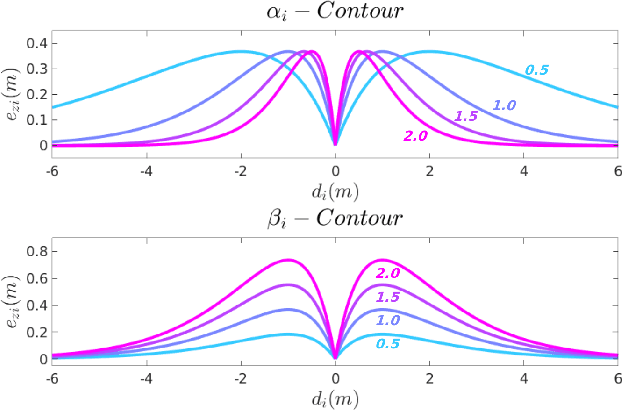George Nikolakopoulos
Luleå University of Technology
Cloud-Assisted Remote Control for Aerial Robots: From Theory to Proof-of-Concept Implementation
Sep 04, 2025Abstract:Cloud robotics has emerged as a promising technology for robotics applications due to its advantages of offloading computationally intensive tasks, facilitating data sharing, and enhancing robot coordination. However, integrating cloud computing with robotics remains a complex challenge due to network latency, security concerns, and the need for efficient resource management. In this work, we present a scalable and intuitive framework for testing cloud and edge robotic systems. The framework consists of two main components enabled by containerized technology: (a) a containerized cloud cluster and (b) the containerized robot simulation environment. The system incorporates two endpoints of a User Datagram Protocol (UDP) tunnel, enabling bidirectional communication between the cloud cluster container and the robot simulation environment, while simulating realistic network conditions. To achieve this, we consider the use case of cloud-assisted remote control for aerial robots, while utilizing Linux-based traffic control to introduce artificial delay and jitter, replicating variable network conditions encountered in practical cloud-robot deployments.
* 6 pages, 7 figures, CCGridW 2025
SPADE: Towards Scalable Path Planning Architecture on Actionable Multi-Domain 3D Scene Graphs
May 25, 2025Abstract:In this work, we introduce SPADE, a path planning framework designed for autonomous navigation in dynamic environments using 3D scene graphs. SPADE combines hierarchical path planning with local geometric awareness to enable collision-free movement in dynamic scenes. The framework bifurcates the planning problem into two: (a) solving the sparse abstract global layer plan and (b) iterative path refinement across denser lower local layers in step with local geometric scene navigation. To ensure efficient extraction of a feasible route in a dense multi-task domain scene graphs, the framework enforces informed sampling of traversable edges prior to path-planning. This removes extraneous information not relevant to path-planning and reduces the overall planning complexity over a graph. Existing approaches address the problem of path planning over scene graphs by decoupling hierarchical and geometric path evaluation processes. Specifically, this results in an inefficient replanning over the entire scene graph when encountering path obstructions blocking the original route. In contrast, SPADE prioritizes local layer planning coupled with local geometric scene navigation, enabling navigation through dynamic scenes while maintaining efficiency in computing a traversable route. We validate SPADE through extensive simulation experiments and real-world deployment on a quadrupedal robot, demonstrating its efficacy in handling complex and dynamic scenarios.
A Hierarchical Graph-Based Terrain-Aware Autonomous Navigation Approach for Complementary Multimodal Ground-Aerial Exploration
May 20, 2025Abstract:Autonomous navigation in unknown environments is a fundamental challenge in robotics, particularly in coordinating ground and aerial robots to maximize exploration efficiency. This paper presents a novel approach that utilizes a hierarchical graph to represent the environment, encoding both geometric and semantic traversability. The framework enables the robots to compute a shared confidence metric, which helps the ground robot assess terrain and determine when deploying the aerial robot will extend exploration. The robot's confidence in traversing a path is based on factors such as predicted volumetric gain, path traversability, and collision risk. A hierarchy of graphs is used to maintain an efficient representation of traversability and frontier information through multi-resolution maps. Evaluated in a real subterranean exploration scenario, the approach allows the ground robot to autonomously identify zones that are no longer traversable but suitable for aerial deployment. By leveraging this hierarchical structure, the ground robot can selectively share graph information on confidence-assessed frontier targets from parts of the scene, enabling the aerial robot to navigate beyond obstacles and continue exploration.
Estimating Commonsense Scene Composition on Belief Scene Graphs
May 05, 2025Abstract:This work establishes the concept of commonsense scene composition, with a focus on extending Belief Scene Graphs by estimating the spatial distribution of unseen objects. Specifically, the commonsense scene composition capability refers to the understanding of the spatial relationships among related objects in the scene, which in this article is modeled as a joint probability distribution for all possible locations of the semantic object class. The proposed framework includes two variants of a Correlation Information (CECI) model for learning probability distributions: (i) a baseline approach based on a Graph Convolutional Network, and (ii) a neuro-symbolic extension that integrates a spatial ontology based on Large Language Models (LLMs). Furthermore, this article provides a detailed description of the dataset generation process for such tasks. Finally, the framework has been validated through multiple runs on simulated data, as well as in a real-world indoor environment, demonstrating its ability to spatially interpret scenes across different room types.
Design and Evaluation of a UGV-Based Robotic Platform for Precision Soil Moisture Remote Sensing
Apr 25, 2025Abstract:This extended abstract presents the design and evaluation of AgriOne, an automated unmanned ground vehicle (UGV) platform for high precision sensing of soil moisture in large agricultural fields. The developed robotic system is equipped with a volumetric water content (VWC) sensor mounted on a robotic manipulator and utilizes a surface-aware data collection framework to ensure accurate measurements in heterogeneous terrains. The framework identifies and removes invalid data points where the sensor fails to penetrate the soil, ensuring data reliability. Multiple field experiments were conducted to validate the platform's performance, while the obtained results demonstrate the efficacy of the AgriOne robot in real-time data acquisition, reducing the need for permanent sensors and labor-intensive methods.
An Addendum to NeBula: Towards Extending TEAM CoSTAR's Solution to Larger Scale Environments
Apr 18, 2025Abstract:This paper presents an appendix to the original NeBula autonomy solution developed by the TEAM CoSTAR (Collaborative SubTerranean Autonomous Robots), participating in the DARPA Subterranean Challenge. Specifically, this paper presents extensions to NeBula's hardware, software, and algorithmic components that focus on increasing the range and scale of the exploration environment. From the algorithmic perspective, we discuss the following extensions to the original NeBula framework: (i) large-scale geometric and semantic environment mapping; (ii) an adaptive positioning system; (iii) probabilistic traversability analysis and local planning; (iv) large-scale POMDP-based global motion planning and exploration behavior; (v) large-scale networking and decentralized reasoning; (vi) communication-aware mission planning; and (vii) multi-modal ground-aerial exploration solutions. We demonstrate the application and deployment of the presented systems and solutions in various large-scale underground environments, including limestone mine exploration scenarios as well as deployment in the DARPA Subterranean challenge.
A Graph-Based Reinforcement Learning Approach with Frontier Potential Based Reward for Safe Cluttered Environment Exploration
Apr 16, 2025Abstract:Autonomous exploration of cluttered environments requires efficient exploration strategies that guarantee safety against potential collisions with unknown random obstacles. This paper presents a novel approach combining a graph neural network-based exploration greedy policy with a safety shield to ensure safe navigation goal selection. The network is trained using reinforcement learning and the proximal policy optimization algorithm to maximize exploration efficiency while reducing the safety shield interventions. However, if the policy selects an infeasible action, the safety shield intervenes to choose the best feasible alternative, ensuring system consistency. Moreover, this paper proposes a reward function that includes a potential field based on the agent's proximity to unexplored regions and the expected information gain from reaching them. Overall, the approach investigated in this paper merges the benefits of the adaptability of reinforcement learning-driven exploration policies and the guarantee ensured by explicit safety mechanisms. Extensive evaluations in simulated environments demonstrate that the approach enables efficient and safe exploration in cluttered environments.
Collision-free landing of multiple UAVs on moving ground vehicles using time-varying control barrier functions
Apr 08, 2025



Abstract:In this article, we present a centralized approach for the control of multiple unmanned aerial vehicles (UAVs) for landing on moving unmanned ground vehicles (UGVs) using control barrier functions (CBFs). The proposed control framework employs two kinds of CBFs to impose safety constraints on the UAVs' motion. The first class of CBFs (LCBF) is a three-dimensional exponentially decaying function centered above the landing platform, designed to safely and precisely land UAVs on the UGVs. The second set is a spherical CBF (SCBF), defined between every pair of UAVs, which avoids collisions between them. The LCBF is time-varying and adapts to the motions of the UGVs. In the proposed CBF approach, the control input from the UAV's nominal tracking controller designed to reach the landing platform is filtered to choose a minimally-deviating control input that ensures safety (as defined by the CBFs). As the control inputs of every UAV are shared in establishing multiple CBF constraints, we prove that the control inputs are shared without conflict in rendering the safe sets forward invariant. The performance of the control framework is validated through a simulated scenario involving three UAVs landing on three moving targets.
Combined Aerial Cooperative Tethered Carrying and Path Planning for Quadrotors in Confined Environments
Apr 01, 2025Abstract:In this article, a novel combined aerial cooperative tethered carrying and path planning framework is introduced with a special focus on applications in confined environments. The proposed work is aiming towards solving the path planning problem for the formation of two quadrotors, while having a rope hanging below them and passing through or around obstacles. A novel composition mechanism is proposed, which simplifies the degrees of freedom of the combined aerial system and expresses the corresponding states in a compact form. Given the state of the composition, a dynamic body is generated that encapsulates the quadrotors-rope system and makes the procedure of collision checking between the system and the environment more efficient. By utilizing the above two abstractions, an RRT path planning scheme is implemented and a collision-free path for the formation is generated. This path is decomposed back to the quadrotors' desired positions that are fed to the Model Predictive Controller (MPC) for each one. The efficiency of the proposed framework is experimentally evaluated.
Toward Fully Autonomous Flexible Chunk-Based Aerial Additive Manufacturing: Insights from Experimental Validation
Feb 27, 2025Abstract:A novel autonomous chunk-based aerial additive manufacturing framework is presented, supported with experimental demonstration advancing aerial 3D printing. An optimization-based decomposition algorithm transforms structures into sub-components, or chunks, treated as individual tasks coordinated via a dependency graph, ensuring sequential assignment to UAVs considering inter-dependencies and printability constraints for seamless execution. A specially designed hexacopter equipped with a pressurized canister for lightweight expandable foam extrusion is utilized to deposit the material in a controlled manner. To further enhance precise execution of the printing, an offset-free Model Predictive Control mechanism is considered compensating reactively for disturbances and ground effect during execution. Additionally, an interlocking mechanism is introduced in the chunking process to enhance structural cohesion and improve layer adhesion. Extensive experiments demonstrate the framework's effectiveness in constructing precise structures of various shapes while seamlessly adapting to practical challenges, proving its potential for a transformative leap in aerial robotic capability for autonomous construction.
 Add to Chrome
Add to Chrome Add to Firefox
Add to Firefox Add to Edge
Add to Edge